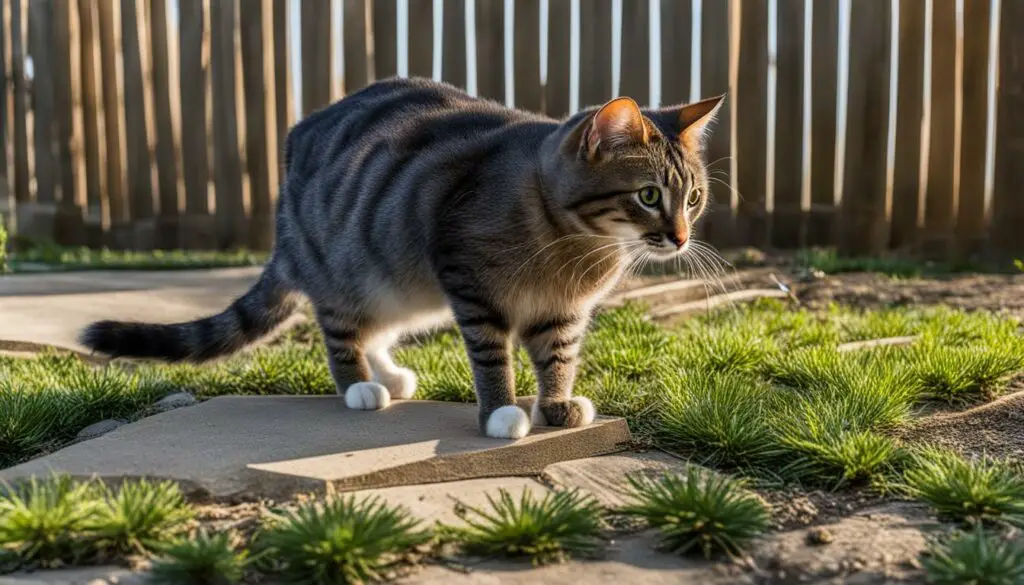Are you planning a move and worried about your outdoor cat getting lost or running away? Moving can be a stressful time for both you and your feline friend, but with the right precautions, you can minimize the risk and ensure a smooth transition for your beloved pet. From micro-chipping and using a collar for identification to preparing a comfortable cat carrier and creating a safe space in the new house, there are several steps you can take to keep your outdoor cat safe and secure during the move.
Key Takeaways:
- Microchip your cat for identification and update your contact details.
- Use a collar with your phone number as an additional identification method.
- Prepare a comfortable cat carrier and allow your cat to get used to it before the move.
- Isolate your cat in one room on moving day to reduce stress and prevent escape.
- Create a room in the new house specifically for your cat with all their essentials.
Microchip Your Cat for Identification
If you have an outdoor cat, it’s important to take precautions to ensure their safety, especially during a move. One of the best ways to protect your cat is by microchipping them. Having your cat microchipped involves inserting a tiny chip under their skin that contains all of your contact information. This way, if your cat ever gets lost, they can be quickly identified and reunited with you.
Microchipping is a simple and safe procedure that can be done by a veterinarian. The chip itself is about the size of a grain of rice and is inserted using a needle. Your cat won’t feel any pain, and the chip will stay in place for their entire life. It’s important to remember to update your contact details on the microchip database when you move or change phone numbers to ensure that the information is always up to date.
By microchipping your cat, you can have peace of mind knowing that they have a form of identification that can never be lost or removed. It’s a small but crucial step in keeping your outdoor cat safe and secure.
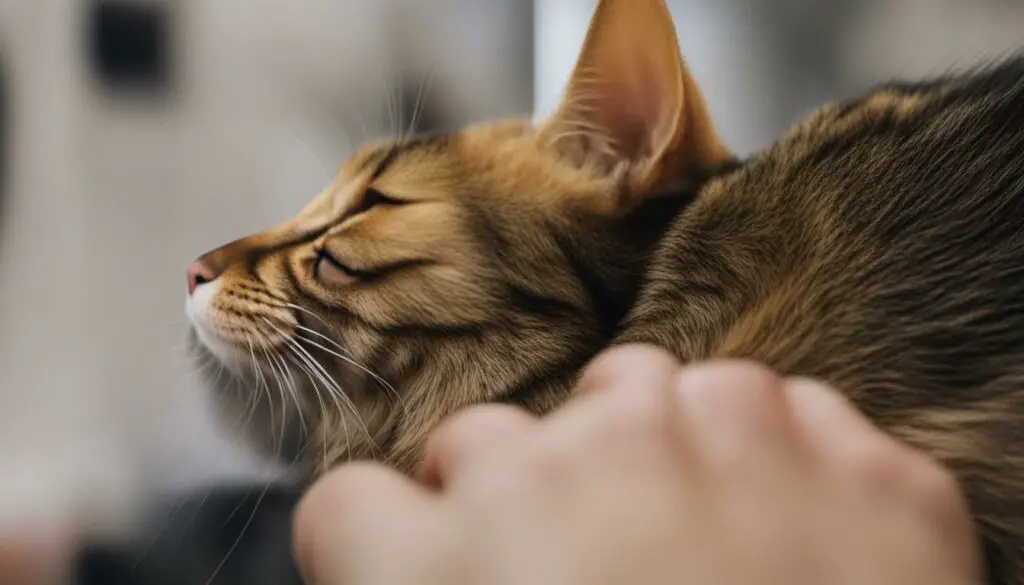
| Benefits of Microchipping Your Cat: |
|---|
| Permanent identification |
| Quick reunification if lost |
| Peace of mind for cat owners |
| Easy procedure with minimal discomfort |
Microchipping your cat is a responsible choice that can greatly increase the chances of a happy reunion if they ever go missing. Don’t wait until it’s too late – make an appointment with your veterinarian today to get your cat microchipped and ensure their safety during your move.
Use a Collar as Additional Identification
When it comes to keeping outdoor cats from running away when you move, microchipping is a crucial step. But to provide an extra layer of identification, it’s also important to use a collar for your cat. A collar with your phone number can serve as a visible form of identification, making it easier for anyone who finds your cat to contact you.
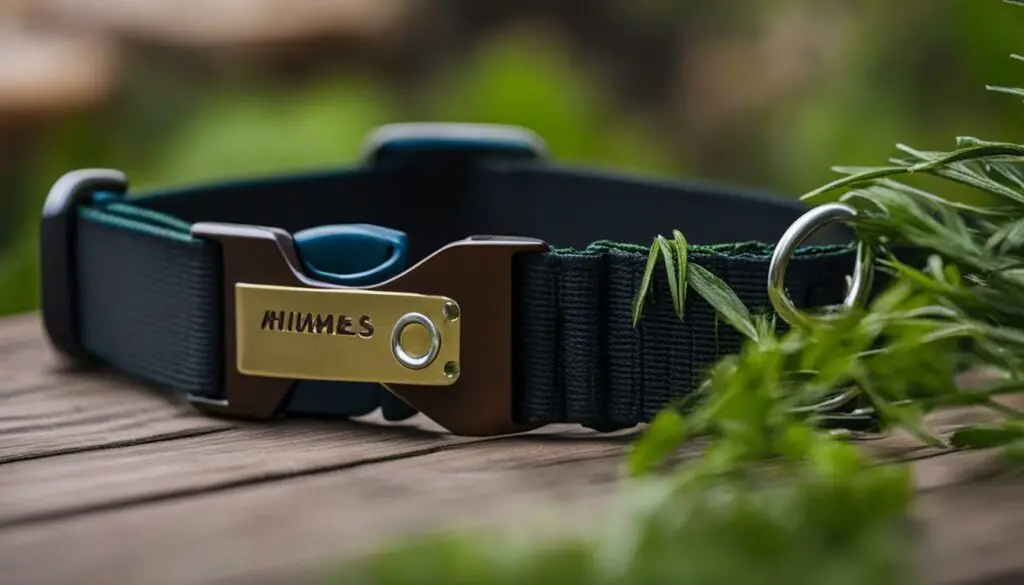
Having a collar with your phone number on it ensures that even if your cat’s microchip goes unnoticed, someone can still reach out to you directly. This can be especially helpful if your cat wanders off and is found by a neighbor or a kind stranger. By including your phone number on the collar, you increase the chances of a swift reunion with your furry friend.
To maximize the effectiveness of the collar, choose one that fits well and is comfortable for your cat to wear. Additionally, make sure to regularly check the collar for any signs of wear and tear, replacing it if necessary. By utilizing both microchipping and a collar, you can provide your outdoor cat with the best possible chance of being identified and returned home safely.
Prepare a Comfortable Cat Carrier
Moving with a cat can be stressful for both you and your feline friend. To ensure a smooth and comfortable journey, it’s important to prepare a suitable cat carrier. Here are some tips to help you prepare:
- Choose a sturdy carrier: Select a carrier that is well-ventilated, secure, and of an appropriate size for your cat. It should have a comfortable interior and a secure latch or locking mechanism to prevent any escapes during the journey.
- Introduce the carrier in advance: To help your cat feel more comfortable in the carrier, leave it out in a familiar area of your home a few days before the move. Place their favorite blanket and even some food inside to encourage positive associations.
- Make it cozy: Line the carrier with a soft blanket or towel to provide a cozy and familiar space for your cat. You can also consider using a pheromone spray or diffuser, such as Feliway, to help create a calming environment.
- Secure the carrier in the car: During the journey, make sure the carrier is properly secured in the car to prevent any sudden movements or accidents. You can use a seatbelt or secure it in a travel crate to ensure your cat’s safety.
Remember, cats may feel anxious or stressed during a move, so it’s essential to create a comfortable and secure environment for them in the carrier. By following these tips, you can help minimize your cat’s stress and ensure a safe and comfortable journey to their new home.
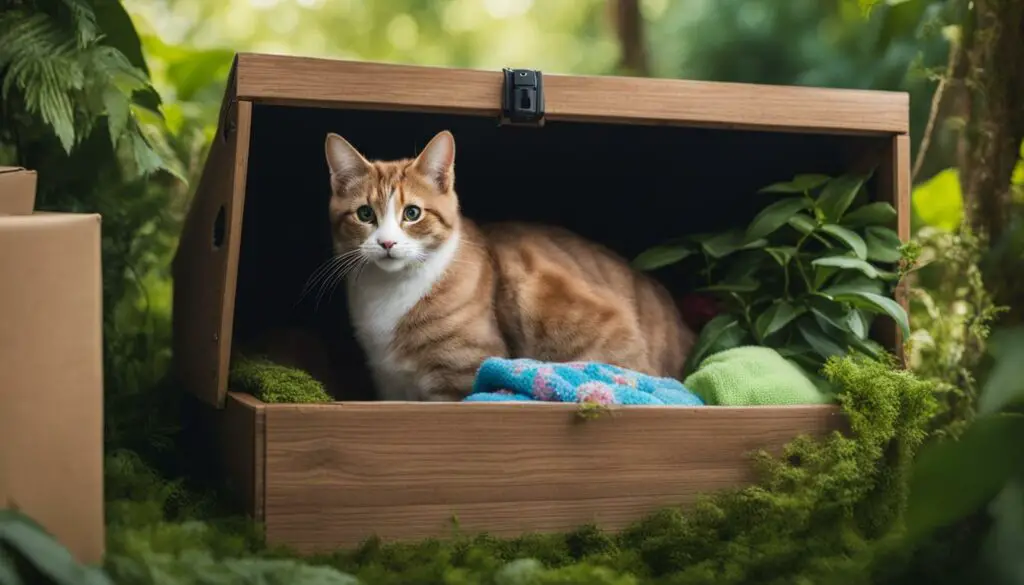
Tips for a Stress-Free Carrier Experience
- Choose a quiet environment: When placing the carrier in your home, select a quiet and peaceful area where your cat can relax and feel secure. Avoid placing it near loud noises or high-traffic areas.
- Practice short trips: If your cat is not accustomed to car rides, gradually introduce them to shorter trips in the carrier before the big move. Start with short drives around the neighborhood and gradually increase the duration to help them acclimate.
- Offer treats and positive reinforcement: Encourage your cat to associate the carrier with positive experiences by offering treats or toys inside. Reward them with praise and treats for calm behavior during the carrier training process.
Table: Choosing the Right Cat Carrier
| Features | Benefits |
|---|---|
| Sturdy construction | Ensures the carrier is durable and secure, preventing any escapes or accidents during the journey. |
| Appropriate size | Provides enough room for your cat to move comfortably, with adequate ventilation for air circulation. |
| Comfortable interior | Includes soft bedding or familiar scents to help your cat feel safe and relaxed during the journey. |
| Secure latch or locking mechanism | Prevents the carrier from accidentally opening and ensures your cat remains safely inside at all times. |
| Easy to clean | Allows for easy maintenance and cleaning, ensuring a hygienic environment for your cat. |
Isolate Your Cat on Moving Day
When it comes to moving day, it’s crucial to prioritize your cat’s well-being and reduce their stress as much as possible. One effective way to achieve this is by isolating your cat in a designated room. By doing so, you create a safe and calm environment for them away from all the chaos and commotion.
In this isolated room, make sure to provide all the essentials your cat needs, such as food, water, litter box, and toys. This ensures that they have everything they need to stay comfortable and content throughout the moving process. Additionally, consider using a Feliway diffuser in the room to help create a soothing atmosphere for your cat.
By isolating your cat on moving day, you not only minimize their exposure to potential hazards but also prevent them from getting overwhelmed and anxious. Keep the door closed at all times and make sure to communicate with everyone involved in the move, so they are aware that the cat is in the designated room.

Table: Checklist for Isolating Your Cat on Moving Day
| Essentials | Actions |
|---|---|
| Food | Ensure your cat has access to their regular food and water supply. |
| Litter Box | Set up a clean and familiar litter box to maintain your cat’s routine. |
| Comfort Items | Provide your cat with their favorite toys, blanket, or bedding to help them feel secure. |
| Feliway Diffuser | Use a Feliway diffuser in the room to create a soothing ambiance and reduce anxiety. |
| Communication | Ensure everyone involved in the move knows that the cat is in the designated room and to keep the door closed. |
Isolating your cat on moving day is a simple yet effective measure to protect their well-being. By providing them with a safe and calm space, you can help reduce their stress levels and ensure a smoother transition into the new environment.
Prepare a Room in the New House for Your Cat
When moving to a new house with your outdoor cat, it’s important to create a safe and comfortable space for them to settle into. Before bringing your cat into the new house, set up a room specifically for them. This room will serve as their sanctuary as they adjust to their new surroundings.
In the cat’s room, include all of their essentials such as food, water, and a litter tray. It’s also a good idea to provide familiar items from their old environment, such as their favorite toys or blankets, to help them feel more at ease. Make sure the room is secure by checking for any potential escape routes, and remove any hazardous items that could harm your cat.
Creating a cozy environment in the cat’s room can also help reduce their anxiety. Consider using Feliway, a pheromone product that helps calm cats, by plugging in a diffuser in the room. This can create a reassuring atmosphere and promote a sense of familiarity for your cat.
| Essentials for Your Cat’s Room: |
|---|
| Food and water bowls |
| Litter tray |
| Comfortable bedding |
| Familiar toys and blankets |
| Feliway diffuser |
“Creating a dedicated room for your cat in the new house will provide them with a sense of security and help them adjust more easily to their new surroundings.”
Gradually Introduce Your Cat to the New Environment
When moving to a new house, it’s important to introduce your cat gradually to its new environment. This process, known as cat acclimation, helps minimize stress and allows your cat to adapt at their own pace. By taking the time to introduce your cat slowly, you can ensure a smoother transition and help them feel more comfortable in their new surroundings.
Start by allowing your cat to explore the room you have prepared for them. This room should be a safe and comfortable space where they can retreat to if they feel overwhelmed. Spend time with your cat in this room, providing reassurance and companionship. By being present and creating a calm atmosphere, you can help alleviate any anxiety they may be experiencing.
Gradually let your cat out of the carrier once the moving noise has died down. Encourage them to explore the room at their own pace, following their natural curiosity. Be patient if they choose to hide initially, as this is a common reaction to new environments. Allow them to come out on their own terms and provide positive reinforcement when they do venture out.
Tips for a gradual introduction:
- Keep the environment quiet and calm during the initial introduction period.
- Provide familiar objects, such as their bed or toys, to help them feel more at ease.
- Use pheromone sprays or diffusers, like Feliway, to create a calming atmosphere.
- Monitor their behavior and adjust the pace of the introduction accordingly.
Remember, every cat is different, and some may require more time to adjust than others. Be patient and understanding throughout the process, allowing your cat to set the pace for their acclimation. With time and patience, your cat will gradually become more comfortable in their new environment.
| Common Behaviors during Cat Acclimation: | How to Respond: |
|---|---|
| Hiding in small, enclosed spaces | Respect their need for privacy and provide hiding spots in their designated room. |
| Loss of appetite or decreased eating | Ensure their food and water are readily available and try enticing them with high-value treats. |
| Excessive vocalization or meowing | Offer comfort and reassurance, and avoid overwhelming them with excessive attention. |
| Increased grooming or licking | Provide distractions, such as interactive toys or scratching posts, to redirect their focus. |
By following these steps and providing a gradual introduction, you can help your cat adjust to their new house in a stress-free manner. Remember, each cat is unique, so be patient and understanding as they adapt to their new environment.
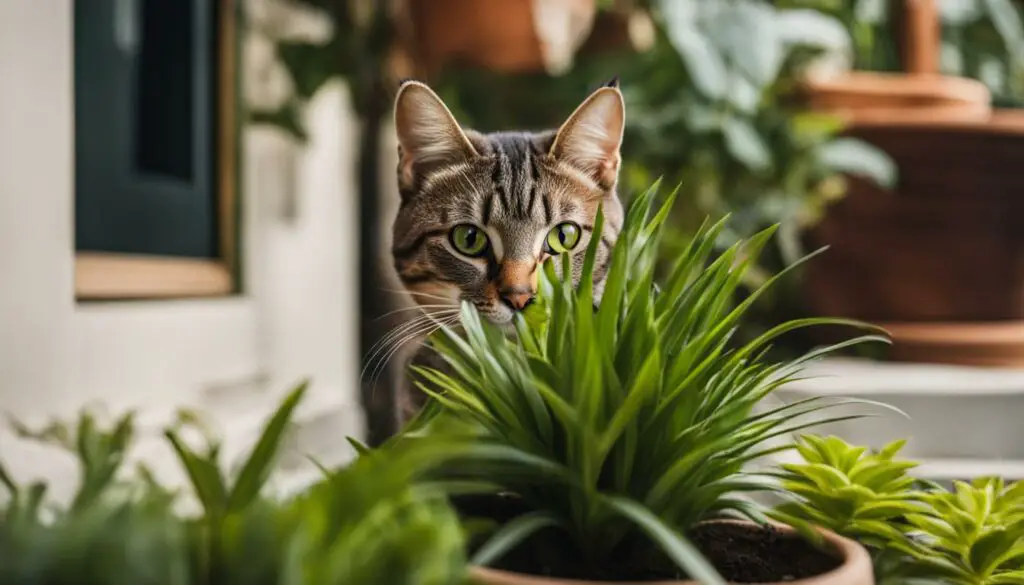
Expand Your Cat’s Access to the New House
Once your cat has become comfortable in their designated room and has had a chance to adjust to the new environment, it’s time to gradually expand their access to the rest of the house. This will allow them to explore and become familiar with their new surroundings. However, it’s important to do this gradually to prevent overwhelming your cat and to ensure their safety.
Start by opening the door to the room and allowing your cat to venture out into the hallway or adjacent rooms. Keep a close eye on them to make sure they don’t show signs of stress or attempt to run away. If they seem relaxed and curious, you can continue to give them access to more areas of the house over the course of a few days or weeks.
Creating a Safe and Cat-Friendly Environment
As you expand your cat’s access to new rooms, it’s important to create a safe and cat-friendly environment. Make sure all potential escape routes, such as windows and doors, are securely closed off. Check for any hazards or small spaces where your cat could get stuck. Provide plenty of hiding spots, such as cat trees or cozy blankets, to help your cat feel secure.
Additionally, ensure that your cat has access to their essentials in each new area of the house. This includes food and water bowls, litter boxes, and comfortable resting areas. By creating a familiar and comfortable environment throughout the house, you can help your cat feel more at ease and reduce their stress levels.
Monitor Your Cat’s Behavior
As your cat explores new rooms, it’s important to monitor their behavior closely. Look for signs of stress or anxiety, such as excessive hiding, excessive grooming, loss of appetite, or aggression. If you notice any concerning behavior, it’s best to limit their access to that particular area and give them time to adjust before trying again.
Remember, each cat is unique and will adjust to their new surroundings at their own pace. Some cats may be more adventurous and adapt quickly, while others may take more time. Be patient with your cat and provide them with plenty of love and reassurance as they continue to explore their new home.
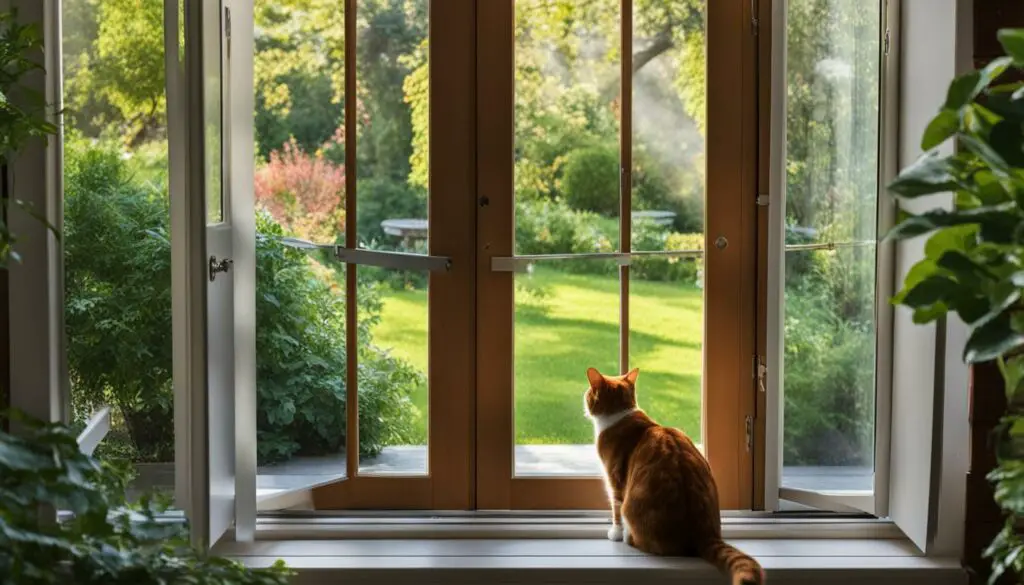
| Benefits of Expanding Your Cat’s Access | Potential Challenges |
|---|---|
| Allows your cat to explore and become familiar with their new environment | Possibility of your cat getting stressed or overwhelmed |
| Helps your cat feel more comfortable and at ease | Potential hazards or escape routes need to be secured |
| Can help prevent boredom and encourage physical activity | Each cat adjusts at their own pace, some may require more time |
Consider Using a Pheromone Diffuser
If you want to create a reassuring environment for your cat during the move, consider using a pheromone diffuser. These diffusers release scents that are designed to reduce stress and anxiety in cats, helping them feel more calm and secure in their new surroundings.
A pheromone diffuser can be particularly beneficial during the acclimation period when your cat is adjusting to the new house. By creating a calming atmosphere, it can help ease any anxieties your cat may have and promote a smoother transition.
To use a pheromone diffuser, simply plug it into an electrical outlet in the room where your cat will be spending a lot of time. The diffuser will emit the pheromone scent, creating a reassuring environment that can have a positive impact on your cat’s well-being.
Remember to give your cat some time to adjust to the pheromone diffuser. Every cat is different, so it may take a few days for them to fully respond to the calming effects. Be patient and observe how your cat reacts to the diffuser, making any necessary adjustments to ensure their comfort.
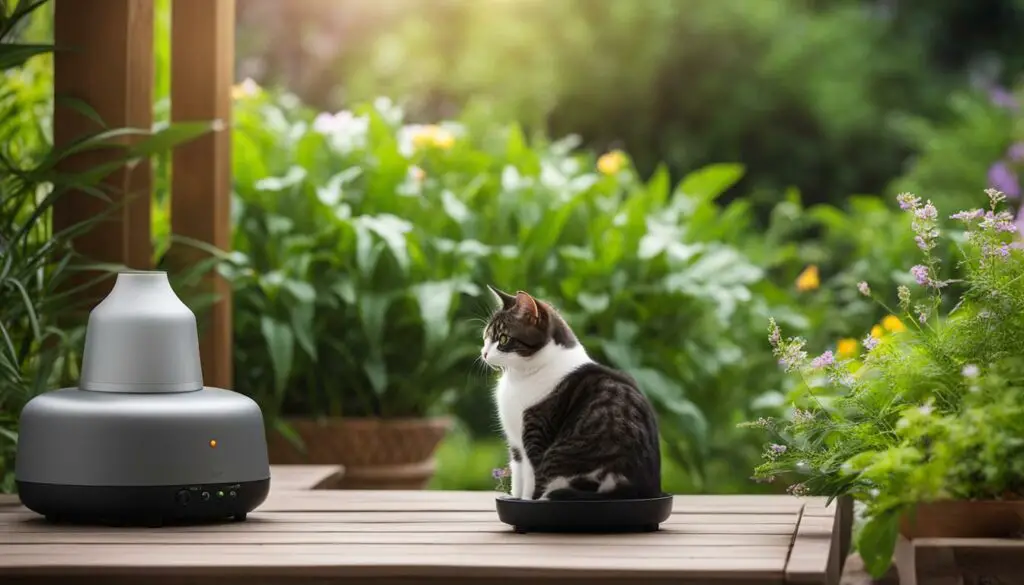
Benefits of Using a Pheromone Diffuser for Your Cat:
- Reduces stress and anxiety
- Creates a calming environment
- Promotes a smoother transition during the move
- Helps ease your cat’s anxieties during the acclimation period
- Contributes to your cat’s overall well-being and comfort
Key Features to Look for in a Pheromone Diffuser:
- Long-lasting effects
- Easy to use and set up
- Suitable for the size of the room
- Safe for both cats and humans
- Provides a continuous release of pheromones
Expert Quote:
“Using a pheromone diffuser can be a valuable tool in helping your cat feel more secure during a move. It creates a reassuring environment that can alleviate stress and promote a smoother transition.” – Dr. Sarah Johnson, Veterinary Behaviorist
Be Patient with Your Cat’s Adjustment
Adjusting to a new environment can be challenging for cats, particularly outdoor cats who are accustomed to a specific territory. During this adjustment period, it’s crucial to be patient and understanding. Each cat is unique and will adapt to change at their own pace.
Creating a welcoming environment is key to helping your cat settle into their new surroundings. Provide them with familiar items such as their favorite toys, blankets, and food. This will help create a sense of comfort and security.
Remember to spend quality time with your cat, offering reassurance and affection. This will help reduce any anxieties they may have during the adjustment period. Patience is key as your cat may exhibit changes in behavior or temperament as they navigate their new territory.
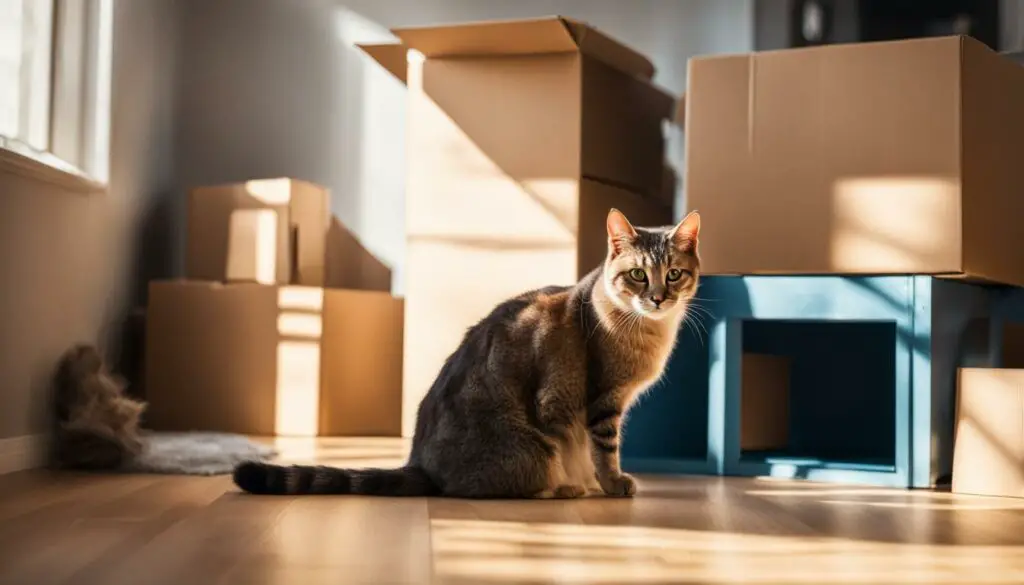
Keep Your Cat Indoors for Two Weeks
After the move, it’s crucial to keep your cat indoors for at least two weeks to help them adjust to their new surroundings and prevent them from running away. This acclimation period allows them to establish the new house as their base and familiarize themselves with the layout and scents of their new environment.
During this time, create a safe and comfortable space for your cat by setting up a room specifically for them. Include all their essentials, such as food, water, litter box, toys, and a cozy bed. Make sure the room is secure, with no potential escape routes, and provide plenty of hiding spots where your cat can feel safe and secure.
While your cat is indoors, spend quality time with them, providing affection, playtime, and mental stimulation. This will help them feel loved and reassured as they navigate the adjustment period. Use interactive toys, scratching posts, and puzzle feeders to keep them entertained and prevent boredom.
Remember to be patient and understanding during this time. Each cat adjusts at their own pace, and it’s normal for them to exhibit signs of stress or anxiety. If you notice any concerning behaviors, consult with your veterinarian for guidance. Providing a calm and nurturing environment will help your cat feel more confident and secure in their new home.

Benefits of Keeping Your Cat Indoors
Keeping your cat indoors for the initial two weeks after a move offers several benefits:
- Preventing your cat from running away and getting lost in an unfamiliar area
- Allowing your cat to become familiar with their new home and surroundings
- Reducing the risk of your cat encountering potential dangers, such as traffic or aggressive animals
- Building a strong bond between you and your cat through quality time spent together indoors
- Creating a sense of security and comfort for your cat as they adjust to the changes
By keeping your cat indoors for the recommended period, you are taking proactive steps to ensure their safety and well-being during the transition. Remember to gradually introduce them to the outdoor environment once they have fully acclimated to their new home, using a secure outdoor space or supervised outings.
Creating a Safe Outdoor Space for Your Cat
When it’s time to introduce your outdoor cat to their new surroundings, it’s crucial to create a safe outdoor space for them. This will allow them to enjoy the outdoors while minimizing the risks they may encounter. One effective way to achieve this is by setting up an outdoor cat enclosure or a cat-proof garden.
An outdoor cat enclosure provides a secure and enclosed space where your cat can experience the outdoors without being exposed to potential dangers. It can be a large, fenced-in area or even a cat-specific tent that allows your furry friend to enjoy fresh air and sunlight while remaining protected. Creating an enclosed space ensures that your cat won’t wander off or be at risk of encounters with predators or traffic.
Alternatively, you can cat-proof your garden by making a few modifications to ensure your cat’s safety. Start by checking for any potential escape routes, such as holes in fences or gaps under gates, and secure them to prevent your cat from getting out. Remove any toxic plants or chemicals that could harm your cat, and consider installing cat-friendly features like shelves, perches, or hiding spots to keep your cat entertained and stimulated.

Supervise your cat closely during their outdoor explorations, especially in the beginning, to ensure they stay within the designated outdoor space. Gradually increase their outdoor time, allowing them more freedom as they become comfortable with their new surroundings. Always provide an easy route back inside if they become frightened or anxious.
Creating a safe outdoor space for your cat not only allows them to experience the joys of the outdoors but also provides you with peace of mind knowing that they are protected from potential hazards. By following these steps, you can help ensure that your outdoor cat stays safe and secure in their new environment.
Conclusion
In summary, caring for your outdoor cat during a move requires careful planning and attention. By following these tips, you can minimize stress and reduce the chances of your cat running away. Begin by micro-chipping your cat and updating your contact information to ensure a swift reunion if they get lost. Additionally, provide them with a collar displaying your phone number as an extra identification method.
Prepare a comfortable cat carrier for the move, allowing your cat to become familiar with it beforehand. On moving day, isolate your cat in a quiet room with all their essentials to minimize stress. Consider using a pheromone diffuser to create a calming environment.
After the move, gradually introduce your cat to their new surroundings, starting with a dedicated room filled with familiar items. Expand their access to other rooms over time, always being aware of potential escape routes. Be patient with your cat’s adjustment period and provide them with love and understanding.
For at least two weeks, keep your cat indoors to establish the new house as their base. When they are ready to venture outside, create a safe outdoor space for them to explore, ensuring it is secure and free from potential hazards. By following these steps, you can help your outdoor cat thrive in their new environment. Remember, a little extra care and attention goes a long way in keeping your furry friend safe and happy during a move.
FAQ
How can I keep my outdoor cat from running away when I move?
Follow these tips to minimize stress and help your outdoor cat adjust to their new environment.
Why should I microchip my cat?
Microchipping your cat ensures that they can be quickly reunited with you if they get lost.
What should I do if my cat gets lost during the move?
If your cat gets lost, make sure to update your contact details on the microchip database and consider leaving your phone number for the people moving into your old house.
How do I prepare a comfortable cat carrier for the move?
Leave the carrier out with your cat’s favorite blanket and some food inside to help them get comfortable with it before the move.
Why should I isolate my cat on moving day?
Isolating your cat in one room on moving day helps reduce stress and keeps them away from the chaos.
How should I prepare a room in the new house for my cat?
Set up a room specifically for your cat with all their essentials, such as food, water, litter box, and toys.
How should I introduce my cat to the new environment?
Spend time with your cat in the room you prepared for them and gradually let them explore once the moving noise has died down.
When can I start expanding my cat’s access to the new house?
After a few days, you can gradually allow your cat to explore more rooms in the new house.
What is a pheromone diffuser, and how can it help my cat?
A pheromone diffuser releases scents that help reduce stress and anxiety in cats, creating a calming environment.
How long does it typically take for a cat to adjust to a new house?
Each cat is different, but it may take a few weeks for your cat to fully adjust to their new surroundings.
Why should I keep my cat indoors for two weeks after the move?
Keeping your cat indoors helps them become fully acclimated to the new house and reduces the chances of them trying to return to the old house.
How can I create a safe outdoor space for my cat?
Consider creating a closed-off area in your garden that is secure and free from potential dangers.

